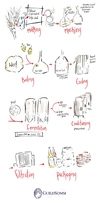Beer Flashcards
(19 cards)
What is “wort”?
A sugar-rich liquid, derived from malted grain
What is the first step in making beer?
Creating the malt
What are the steps of malting?
- Grains are steeped in water to promote germination - Sprout emerges, and grain is transferred to compartments with controlled temps to allows the grain to grow about an inch. - The grain then produces amylase, making it fermentable. - Grains are then roasted in a kiln to halt growth. The amount of roast will determine style of beer (pale, caramel, toffee, chocolate, coffee, black…)
What is Amylase?
An enzyme produced from spouted grains that are responsible for converting storage into sugars (maltose and dextrin).
What is Hops and what does it do?
A flower that adds flavor and bitterness, and has both preservative and antiseptic qualities that prohibit bacterial growth
Grist
Grains are ground or cracked in a mill (dry mash)
Mash
Grist that is soaked in water for about 2 hours converting and extracting sugar from the malt, and results in the flavor-, sugar- and color-rich wort.
Copper
A brew kettle that the wort liquid is drawn off grains and filtered into. Often boiled for 1-2 hours after this process.
Sparge
Additional sugar and flavor may be extracted from the spent grains by sparging—rinsing with fresh water.
When are hops added?
When the spare and wort are combined in the copper.
What yeast is used for Ales and how quick is fermentation?
- Saccharomyces cerevisiae - Top fermenting yeast - prefers warmer temps - QUICK. 1 week.
What yeast is used for Lagers and how quick is fermentation?
- Saccharomyces carlsbergensis - Bottom Fermenting yeast - Colder temps - SLOW
Flavor profile of ales?
Fruity and richly-flavored beers
Flavor profiles of lagers?
A more delicate, cleaner beer
How do you make beer?

What temp should lagers be served at?
48-52 degreed F
What temp should lighter Ales be served at?
54-57 degrees F
What temp should Draght beer be served?
54-57 degrees F
Which beers should be served at a cool room temperature?
- Trappist
- Lambic
- Stouts
- Brown Ales
- Strong Ales


